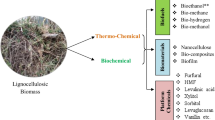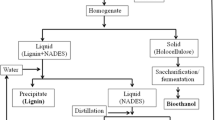Abstract
Enzymatic hydrolysis of lignocellulosic biomass is a crucial step for bioethanol production. Highly balanced composition of cellulases and hemicellulases are required for effective bioconversion of lignocellulose into fermentable sugars. As commercial cellulases are often poor in certain hemicellulolytic activities, supplementation of such cellulases with accessory hemicellulolytic enzymes can yield high concentration of fermentable sugars. In the present investigation an attempt was made to develop a balanced cocktail for enzymatic hydrolysis of maize stover. Mild alkali treatment (2% NaOH) of maize stover was found to be beneficial as substrate loss was minimum and holocellulose content was unaffected. Response surface methodology was used for optimization of enzymatic saccharification process using three variables viz. level of crude β-xylosidase, level of commercial cellulases and time. Maximum 601.7 mg/g reducing sugars were obtained with 78.33% saccharification yield using optimum parameters viz 13.0 FPU/g commercial cellulase (MAPs 450), 74.42 U/g crude β-xylosidase and 36 h. Further, the role of accessory hemicellulolytic enzymes was proved by replacing crude β-xylosidase with partially purified β-xylosidase. As compared to crude β-xylosidase, supplementation of partially purified β-xylosidase at the same level, yield of reducing sugars was 536 mg/g which is only 11% lesser than crude enzyme. Moreover, developed enzyme cocktail was equally efficient at low temperature (30 °C) and at high substrate loading (30%). Enzymatic hydrolysate obtained after saccharification was efficiently fermented by ethanologenes.







Similar content being viewed by others
References
Dalgaard, T., Jorgensen, U., Olesen, J.E., Jensen, E.S., Kristensen, E.S.: Looking at biofuels and bioenergy. Science 312, 1743–11743 (2006)
Wyman, C.E.: Biomass ethanol: technical progress, opportunities and commercial challenges. Annu. Rev. Energy. Environ. 24, 189–226 (1999)
Chen, S.F., Mowery, R.A., Scarlata, C.J., Chambliss, C.K.: Compositional analysis of water-soluble materials in corn stover. J. Agri. Food Chem. 55(15), 5912–5918 (2007)
Perlack, R.D., Wright, L.L., Turhollow, A.F., Graham, R.L., Stokes, B.J., Erbach, D.C.: Biomass as feedstock for a bioenergy and bioproduct industry: the technical feasibility of a billion-ton annual supply, U.S. DOE and USDA (2005)
Hu, Z., Wen, Z.: Enhancing enzymatic digestibility of switchgrass by microwave-assisted alkali pretreatment. Biochem. Eng. J. 38, 369–378 (2008)
Keshwani, D.R., Cheng, J.J.: Microwave-based alkali pretreatment of switchgrass and coastal bermudagrass for bioethanol production. Biotechnol. Progr. 26, 644–652 (2010)
Lau, M.W., Dale, B.E., Balan, V.: Ethanolic fermentation of hydrolysates from ammonia fiber expansion (AFEX) treated corn stover and distillers grain without detoxification and external nutrient supplementation. Biotechnol. Bioeng. 99, 529–539 (2008)
Millet, M.A., Baker, A.J., Scatter, L.D.: Physical and chemical and pretreatment for enhancing cellulose saccharification. Biotechnol. Bioeng. Symp. 6, 125–153 (1976)
Zhu, Y., Lee, Y.Y., Elander, R.T.: Dilute-acid pretreatment of corn stover using a high-solids percolation reactor. Appl. Biochem. Biotechnol. 117, 103–114 (2004)
Mesquita, J.F., Ferraz, A., Aguiar, A.: Alkaline-sulfite pretreatment and use of surfactants during enzymatic hydrolysis to enhance ethanol production from sugarcane bagasse. Biopro. Biosys. Eng. (2015). doi:10.1007/s00449-015-1527-z
Patel, H., Chapla, D., Divecha, J., Shah, A.: Improved yield of α-L-arabinofuranosidase by newly isolated Aspergillus niger ADH-11 and synergistic effect of crude enzyme on saccharification of maize stover. Bioresour. Bioproces. 2, 11 (2015). doi:10.1186/s40643-015-0039-7
Gaspar, M., Kalman, G., Reczey, K.: Corn fiber as a raw material for hemicellulose and ethanol production. Process Biochem. 42, 1135–1139 (2007)
Kumar, R., Wyman, C.E.: Effects of cellulase and xylanase enzymes on the deconstruction of solids from pretreatment of poplar by leading technologies. Biotechnol. Prog. 25, 302–314 (2009)
Modenbach, A.A., Nokes, S.E.: Enzymatic hydrolysis of biomass at high-solid loadings-a review. Biomass Bioeng. 56, 526–544 (2013)
Koppram, R., Tomas-Pejo, E., Xiros, C., Olsson, L.: Lignocellulosic ethanol production at high-gravity: challenge and perspectives. Trend Biotechnol. 32(1), 46–53 (2014)
Patel, H., Divecha, J., Shah, A.: Enhanced production of β-xylosidase from Aspergillus niger ADH-11 and development of synergistic enzyme cocktail for saccharification of sugarcane bagasse. Curr. Biotechnol. (2016). doi:10.2174/2211550105666151207184921
Lowry, O.H., Rosebrough, N.J., Farr, A.L., Randall, R.J.: Protein measurement with the folin phenol reagent. J. Biol. Chem. 31, 426–428 (1951)
Goering, H.K., Van Soest, P.J.: Forage fiber analysis (Apparatus, Reagent, Procedure and Some application). Agricultural Handbook no. 379, 1–20. Agricultural Research Service-United States Department of Agricultural. USDA, Washington DC (1970)
Sun, Y., Cheng, J.: Hydrolysis of lignocellulosic materials for ethanol production: a review. Bioresour. Technol. 83, 1–11 (2002)
Chen, M., Zhao, J., Xia, L.: Comparison of four different chemical pretreatments of corn stover for enhancing enzymatic digestibility. Biomass Bioenerg. 33(10), 1381–1385 (2009)
Joglekar, A.M., May, A.T.: Product excellence through design of experiments. Cereal. Foods World. 32, 857–868 (1987)
Kristensen, J.B., Felby, C., Jørgensen, H.: Yield-determining factors in high-solids enzymatic hydrolysis of lignocellulose. Biotechnol. Biofuels 2, 11 (2009). doi:10.1186/1754-6834-2-11
Acknowledgements
Authors gratefully acknowledge Department of Biotechnology (DBT), New Delhi, India and Gujarat State Biotechnology Mission (GSBTM), Gandhinagar, Gujarat, India for providing the research grants to support this work and also thankful to MAPs Enzyme Limited, India for providing cellulase enzyme.
Author information
Authors and Affiliations
Corresponding author
Rights and permissions
About this article
Cite this article
Patel, H., Divecha, J. & Shah, A. Efficient Enzymatic Digestion of Alkali Treated Maize Stover Holocellulose by Developing Balanced Cocktail of Cellulolytic and Hemicellulolytic Enzymes. Waste Biomass Valor 8, 1969–1979 (2017). https://doi.org/10.1007/s12649-016-9769-9
Received:
Accepted:
Published:
Issue Date:
DOI: https://doi.org/10.1007/s12649-016-9769-9




